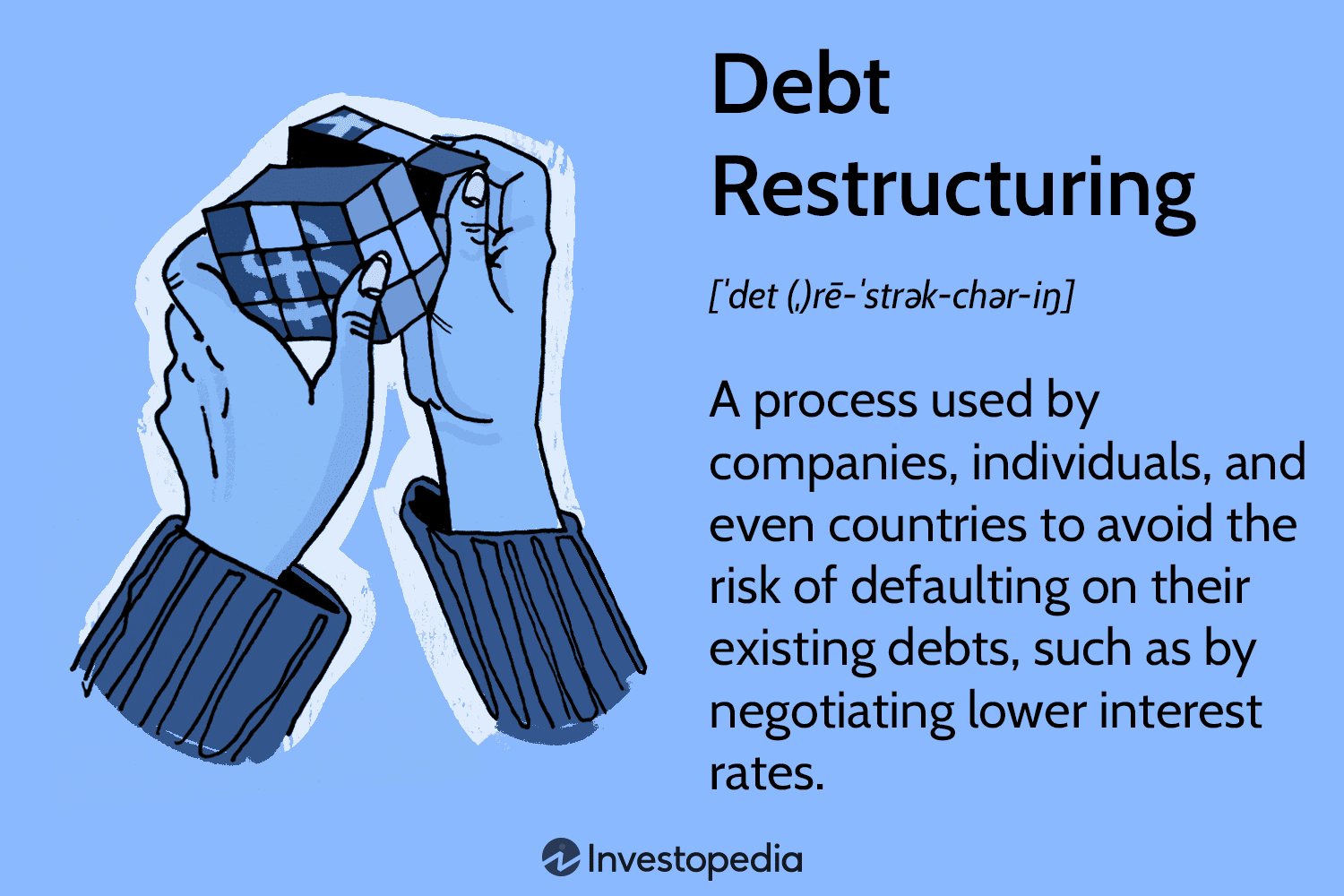Debt restructuring can be a game-changer when it comes to managing your finances. But what exactly is debt restructuring and how does it work? In simple terms, debt restructuring is a process that allows individuals or businesses to reorganize their existing debts in order to make them more manageable. It offers a lifeline to those struggling with overwhelming financial burdens, giving them an opportunity to regain control. By renegotiating terms, interest rates, or even extending repayment periods, debt restructuring provides a fresh start and a chance to rebuild your financial stability. Let’s delve deeper into how this powerful tool can help you get back on track.
What is Debt Restructuring and How It Works
Debt restructuring is a process that allows individuals or businesses to modify the terms of their existing debt obligations in order to make repayment more manageable. When facing financial challenges, such as high interest rates, large monthly payments, or the risk of default, debt restructuring can provide much-needed relief and allow for a more sustainable financial future.
Debt restructuring typically involves negotiating with creditors to modify the terms of the debt, including interest rates, repayment periods, and sometimes even the principal balance. This allows the debtor to create a new repayment plan that aligns with their current financial situation and ability to repay. The ultimate goal is to make the debt more affordable and avoid potential bankruptcy or insolvency.
The Process of Debt Restructuring
Debt restructuring involves a series of steps that aim to find a mutually beneficial solution for both the debtor and the creditor. Here’s a breakdown of the typical process:
1. Assessment of Financial Situation
Before embarking on the debt restructuring journey, it is important to conduct a comprehensive assessment of your financial situation. This includes gathering all relevant financial information, such as outstanding debts, income, expenses, and assets. Analyzing these details will help you understand the extent of your financial burden and determine the best course of action.
2. Creating a Budget
Once you have a clear picture of your financial situation, creating a detailed budget is crucial. A budget allows you to allocate your income towards essential expenses, debt repayment, and savings. It helps you identify areas where you can cut costs and maximize your available funds for debt repayment.
3. Contacting Creditors
After assessing your financial situation and creating a budget, the next step is to reach out to your creditors. Contact them to express your desire to restructure your debt and discuss the available options. It’s important to approach these conversations with transparency and honesty, as this will increase the likelihood of finding a favorable resolution.
4. Negotiating with Creditors
During the negotiation process, your main objective is to convince creditors to agree to modified terms of the debt. This may include reducing the interest rate, extending the repayment period, or even accepting a lump sum payment. Negotiations can be complex, and it’s often helpful to work with a financial advisor or debt restructuring expert who can guide you through the process.
5. Formalizing a Repayment Plan
Once an agreement is reached with your creditors, it’s essential to formalize the new repayment plan. This typically involves documenting the terms and conditions of the restructuring arrangement in a legally binding agreement. The agreement should outline the modified repayment schedule, interest rates, and any other terms agreed upon during negotiations.
6. Adhering to the Repayment Plan
With the debt restructuring agreement in place, it’s crucial to adhere to the new repayment plan diligently. Make sure to make all payments on time and in the agreed-upon amounts. Failure to comply with the terms of the agreement could result in the reinstatement of the original debt terms and potentially worsen your financial situation.
Potential Benefits of Debt Restructuring
Debt restructuring can offer several advantages for individuals or businesses facing financial challenges. Some of the potential benefits include:
- Lower Interest Rates: Debt restructuring can result in reduced interest rates, which can significantly decrease the overall cost of borrowing.
- Smaller Monthly Payments: By extending the repayment period or reducing the principal balance, debt restructuring can lower the monthly payment burden.
- Avoiding Bankruptcy: Debt restructuring provides an opportunity to address financial difficulties without resorting to bankruptcy, which can have severe long-term consequences.
- Preserving Creditworthiness: Successfully restructuring debt helps protect your credit score and maintain a positive credit history, which is crucial for future financial endeavors.
- Financial Relief: Debt restructuring can alleviate stress and provide a sense of relief, allowing individuals or businesses to focus on rebuilding their financial stability.
Is Debt Restructuring the Right Option for You?
While debt restructuring can be beneficial, it’s important to evaluate your individual circumstances and consider whether it’s the right option for you. Here are some factors to consider:
1. Financial Situation
Assess the severity of your financial situation. If you’re struggling to meet your debt obligations and are at risk of defaulting or facing legal action, debt restructuring may be a viable solution.
2. Willingness to Work with Creditors
Debt restructuring requires open communication and negotiations with your creditors. If you’re comfortable engaging in these discussions and believe your creditors may be open to modifying the terms, debt restructuring could be a suitable choice.
3. Long-Term Financial Outlook
Consider your long-term financial goals and prospects. If you anticipate a significant increase in income or improvement in your financial situation in the near future, debt restructuring may help bridge the gap until you can comfortably meet your debt obligations.
4. Professional Guidance
Obtaining professional advice is crucial when deciding whether debt restructuring is the right option for you. Financial advisors or debt restructuring experts can provide personalized guidance based on your unique circumstances.
Remember, debt restructuring is not a one-size-fits-all solution. It’s essential to weigh the pros and cons and seek professional advice before making a decision.
In conclusion, debt restructuring offers a lifeline to individuals and businesses struggling with overwhelming debt. By renegotiating the terms of existing debt, debtors can create a more manageable repayment plan that aligns with their financial capabilities. It’s important to approach the process with careful planning, open communication with creditors, and a realistic understanding of one’s financial situation. Debt restructuring can provide the necessary financial relief to help individuals and businesses regain control of their finances and move towards a more stable future.
Debt Restructuring Explained | Management & Business Concepts
Frequently Asked Questions
Frequently Asked Questions (FAQs)
What is debt restructuring and how does it work?
Debt restructuring is a process where a company or individual negotiates with their creditors to modify the terms of existing debt agreements. It aims to make the debt burden more manageable by reducing interest rates, extending repayment periods, or altering other loan terms.
Why would someone consider debt restructuring?
Debt restructuring is often considered when a borrower is facing financial difficulties and is unable to meet current repayment obligations. It provides an opportunity to reorganize debts and avoid bankruptcy, thus offering a chance for the borrower to regain financial stability.
What are the benefits of debt restructuring?
Debt restructuring can offer several benefits, including reduced monthly payments, lower interest rates, improved cash flow, and the potential to eliminate or consolidate multiple debts into a single payment. It can also help rebuild creditworthiness over time.
Who can opt for debt restructuring?
Debt restructuring is an option for both individuals and businesses. Individuals with excessive credit card debts, personal loans, or mortgages can explore debt restructuring. Similarly, businesses struggling with high-interest loans, commercial leases, or other financial obligations can also consider debt restructuring.
How does debt restructuring affect credit scores?
Debt restructuring may initially have a negative impact on credit scores, as it typically involves negotiation and temporary adjustments to loan terms. However, successfully completing a debt restructuring plan can ultimately improve credit scores by demonstrating responsible financial management and the ability to meet revised payment obligations.
What is the difference between debt restructuring and debt consolidation?
Debt restructuring involves modifying the terms of existing debts, such as interest rates or payment terms, to make them more manageable. On the other hand, debt consolidation involves combining multiple debts into a single loan with a single monthly payment, often with a new lender.
Can debt restructuring help avoid bankruptcy?
Yes, debt restructuring can help avoid bankruptcy by offering an alternative solution to financial difficulties. By renegotiating debt terms, it allows borrowers to repay debts in a more manageable way, potentially preventing the need for bankruptcy and its long-term consequences.
Is debt restructuring a legal process?
Debt restructuring can be a voluntary negotiation process between borrowers and creditors. It requires both parties to agree on modified repayment terms. However, in certain cases, formal legal proceedings such as Chapter 11 bankruptcy may be necessary to implement debt restructuring for businesses or individuals with substantial debt.
Final Thoughts
Debt restructuring is a financial strategy used to alleviate the burden of debt. It involves renegotiating the terms and conditions of existing debts to make them more manageable for the debtor. Typically, this process involves extending the repayment period, reducing the interest rate, or even forgiving a portion of the debt. Debt restructuring aims to provide the debtor with a realistic plan to repay their obligations while avoiding bankruptcy. By restructuring their debt, individuals and businesses can regain control of their finances and work towards becoming debt-free. Overall, debt restructuring is a proactive and effective approach to managing overwhelming debt.



